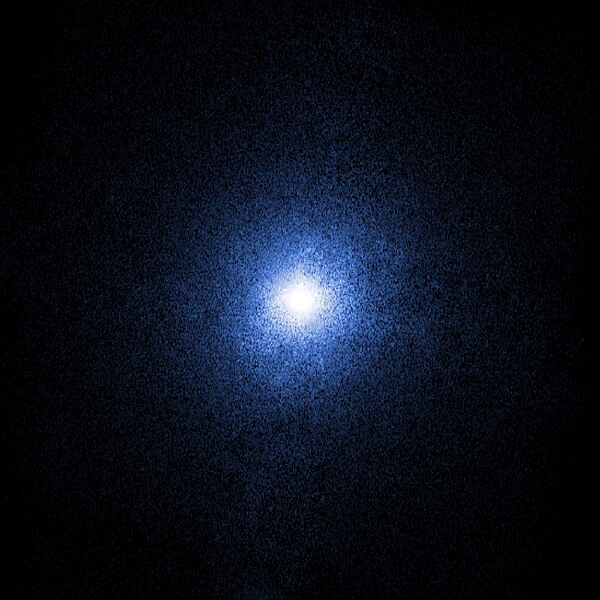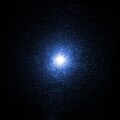
Imagem numa resolução maior (2 400 × 2 400 pixels, tamanho: 3,72 MB, tipo MIME: image/jpeg)
Este arquivo é do Wikimedia Commons e pode ser utilizado por outros projetos. Sua página de descrição de arquivo é reproduzida abaixo.
Descrição do arquivo
| DescriçãoChandra image of Cygnus X-1.jpg |
English: Since its discovery in 1964, Cygnus X-1 has been one of the most intensively studied cosmic X-ray sources. About a decade after its discovery, Cygnus X-1 secured a place in the history of astronomy when a combination of X-ray and optical observations led to the conclusion that it was a black hole, the first such identification.
The Cygnus X-1 system consists of a black hole with a mass about 10 times that of the Sun in a close orbit with a blue supergiant star with a mass of about 20 Suns. Gas flowing away from the supergiant in a fast stellar wind is focused by the black hole, and some of this gas forms a disk that spirals into the black hole. The gravitational energy release by this infalling gas powers the X-ray emission from Cygnus X-1. Although more than a thousand scientific articles have been published on Cygnus X-1, its status as a bright and nearby black hole continues to attract the interest of scientists seeking to understand the nature of black holes and how they affect their environment. Observations with Chandra and ESA's XMM-Newton are especially valuable for studying the property of the stellar wind that fuels Cygnus X-1, and determining its rate of spin. This latter research has revealed that Cygnus X-1 is spinning very slowly. This puzzling result could indicate that Cygnus X-1 may have formed in an unusual type of supernova that somehow prevented the newly formed black hole from acquiring as much spin as other stellar black holes. |
| Data | |
| Fonte | http://www.nasa.gov/images/content/381549main_cygX1_final_665.jpg linked from http://www.nasa.gov/mission_pages/chandra/multimedia/photo09-065.html |
| Autor | NASA's Chandra X-ray Observatory; Credits: NASA/CXC |
Licenciamento
| Public domainPublic domainfalsefalse |
| Esta obra encontra-se no domínio público porque foi criada pela NASA. A política de direitos autorais da NASA diz que "o material da NASA não é protegido por direitos autorais a não ser quando especificado". (página sobre direitos autorais da NASA ou Política de uso de imagens da JPL). |  | |
 |
Avisos:
|
Legendas
Itens retratados neste arquivo
retrata
27 agosto 2009
image/jpeg
fabdeafa80f07828d82bede393ab2c34e841d4da
3 904 228 Byte
2 400 pixel
2 400 pixel
Histórico do arquivo
Clique em uma data/horário para ver como o arquivo estava em um dado momento.
| Data e horário | Miniatura | Dimensões | Usuário | Comentário | |
|---|---|---|---|---|---|
| atual | 19h06min de 13 de agosto de 2015 |  | 2 400 × 2 400 (3,72 MB) | wikimediacommons>Pine | Larger version. Source http://chandra.harvard.edu/photo/2011/cygx1/more.html, credit NASA/CXC |
Uso do arquivo
As seguinte página usa este arquivo:
Metadados
Este ficheiro contém informação adicional, provavelmente adicionada a partir da câmara digital ou scanner utilizada para criar ou digitalizar a imagem. Caso o ficheiro tenha sido modificado a partir do seu estado original, alguns detalhes poderão não refletir completamente as mudanças efetuadas.
| Título |
|
|---|---|
| Autor | Chandra X-ray Observatory Center |
| Data e hora da geração dos dados | 17 de novembro de 2011 |
| Largura | 2 400 px |
| Altura | 2 400 px |
| Bits por componente |
|
| Esquema de compressão | LZW |
| Composição pixel | RGB |
| Orientação | Normal |
| Número de componentes | 3 |
| Resolução horizontal | 0,086206896551724 ppp |
| Resolução vertical | 296 809 ppp |
| Arranjo de dados | formato irregular |
| Software utilizado | Adobe Photoshop CS4 Macintosh |
| Versão Exif | 2.21 |
| Espaço de cor | sRGB |
| Data e hora de digitalização | 10h01min de 25 de agosto de 2009 |
| Data e hora de modificação do arquivo | 09h41min de 16 de novembro de 2011 |
| Data da última modificação dos metadados | 08h32min de 17 de novembro de 2011 |
| Fonte | Chandra X-ray Observatory |
| Título | A stellar-mass black hole in orbit with a companion star located about 6,000 light years from Earth. |
| Atribuição/Fornecedor | Optical: DSS; Illustration: NASA/CXC/M.Weiss |
| Identificação exclusiva do documento original | xmp.did:FA7F117407206811AFFDA177F764B243 |
| Título curto |
|
| Palavras-chave | Cygnus X-1 |
| Informações para contato | [email protected]
60 Garden St. Cambridge, MA, 02138 USA |
| Termos de uso | |
| Versão IIM | 4 |




 " class="attachment-atbs-s-4_3 size-atbs-s-4_3 wp-post-image" alt="O que estudar para o enem 2023">
" class="attachment-atbs-s-4_3 size-atbs-s-4_3 wp-post-image" alt="O que estudar para o enem 2023"> " class="attachment-atbs-s-4_3 size-atbs-s-4_3 wp-post-image" alt="Qual melhor curso para fazer em 2023">
" class="attachment-atbs-s-4_3 size-atbs-s-4_3 wp-post-image" alt="Qual melhor curso para fazer em 2023"> " class="attachment-atbs-s-4_3 size-atbs-s-4_3 wp-post-image" alt="Enem: Conteúdos E Aulas On-Line São Opção Para Os Estudantes">
" class="attachment-atbs-s-4_3 size-atbs-s-4_3 wp-post-image" alt="Enem: Conteúdos E Aulas On-Line São Opção Para Os Estudantes"> " class="attachment-atbs-s-4_3 size-atbs-s-4_3 wp-post-image" alt="Como Fazer Uma Carta De Apresentação">
" class="attachment-atbs-s-4_3 size-atbs-s-4_3 wp-post-image" alt="Como Fazer Uma Carta De Apresentação"> " class="attachment-atbs-s-4_3 size-atbs-s-4_3 wp-post-image" alt="Como Escrever Uma Boa Redação">
" class="attachment-atbs-s-4_3 size-atbs-s-4_3 wp-post-image" alt="Como Escrever Uma Boa Redação"> " class="attachment-atbs-s-4_3 size-atbs-s-4_3 wp-post-image" alt="Concurso INSS edital 2022 publicado">
" class="attachment-atbs-s-4_3 size-atbs-s-4_3 wp-post-image" alt="Concurso INSS edital 2022 publicado">


